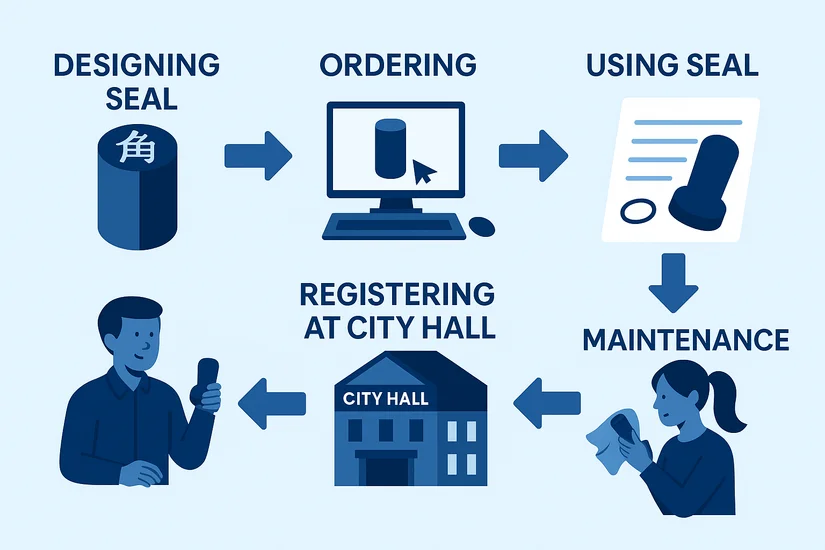How to Get and Register Personal Seal (Inkan) as a Foreigner

Pro Tip
Keep a clear digital scan of your registered seal impression stored securely—this can save weeks of hassle if your physical seal is ever lost or damaged.
Introduction
In Japan, personal seals—known as inkan—are still deeply woven into daily life and bureaucracy. Unlike simple signatures, a registered seal (実印, jitsuin) carries legal weight equivalent to your handwritten name. Foreign residents often face confusion distinguishing between three main types of seals: the casual approval stamp (認印, mitome-in), the bank-specific seal (銀行印, ginkō-in), and the legally registered 実印. This guide walks you through every step—from choosing your seal design and ordering it (online or in-store), to registering it at your local city hall (市役所), and finally, using it correctly in contracts, applications, and official documents. By the end, you’ll understand when and why you need each seal, what paperwork to bring, and how to avoid common pitfalls as a foreigner in Japan.
1. Seal Types: 認印 vs. 銀行印 vs. 実印
| Type | Primary Use | Registration Required? |
|---|---|---|
| 認印 (Mitome-in) | Incoming mail, internal acknowledgments, package delivery | No |
| 銀行印 (Ginkō-in) | Opening and operating bank accounts | No |
| 実印 (Jitsuin) | Real estate, vehicle registration, loan contracts | Yes |
1.1 認印 (Mitome-in)
The 認印 is your casual stamp for everyday use—confirming receipt of parcels, signing internal office forms, or approving simple memos. No official registration is required. While convenient, a mitome-in carries no legal authority in high-stakes matters, so don’t use it for leases or loan agreements.
1.2 銀行印 (Ginkō-in)
Japanese banks typically require a dedicated 銀行印 to open an account and authorize transactions. Although not registered at the city hall, this seal must match exactly what you present to the bank when you apply. Choosing a distinct design helps prevent mix-ups with other seals.
1.3 実印 (Jitsuin)
The 実印 is your legally registered seal, stored on file at your local 市役所. Required for major contracts—such as property purchases, car registrations, power of attorney, and certain visa applications—your jitsuin must be precisely the same shape, size, and inscription as the one on record. Any discrepancy, even small, can void a document.
2. Designing Your Inkan
Design Advice
Choose katakana or roman letters that you can easily reproduce. Opt for a traditional font like 篆書体 (tensho) for durability in impressions, and stick to the 16–18 mm size range recommended for jitsuin.
- Decide on 全角カタカナ
- Select a shape: 丸形 (round) for a classic look, or 角形 (square) for a modern feel.
- Pick a font: 篆書体 for tradition, 明朝体 for readability, or request custom オリジナル刻印.
- Request and verify a digital proof before finalizing your order.
- Confirm spelling, character order, and spacing—any mistake delays registration.
3. Ordering Your Seal
3.1 Online Shops
Ordering online offers convenience and a broader selection of styles. English-friendly sites guide you step-by-step, let you preview your seal, and ship directly to your address. However, allow 3–5 business days for proofing and delivery. Always confirm shipping costs and return policies for incorrect orders.
- Harinacs: Free digital proof, intuitive English interface, standard 3 day delivery.
- Cosmo Seal: Extensive font library, supports roman letters, global shipping.
- Seal Online Japan: Dedicated foreigner support, small design fee for custom logos.
3.2 In-Store Shops
Visiting a physical 印鑑ショップ lets you inspect materials and get same-day pickup. Staff can guide you through proofing, but English support may be limited. Stores often carry traditional woods like 黒檀 (ebony) or 高級柘 (boxwood), chosen for durability.
- 堺筋本町のハンコ卸売センター: Same-day service, reasonable pricing.
- 難波の大黒屋印章: Wide font selection, friendly to walk-ins.
- 心斎橋の印苑: Offers custom carving and free design consultations.
4. Registering Your 実印 at 市役所
Once you have your seal, you must register it at your local ward office (区役所) or city hall (市役所). Registration links your seal’s exact design to your residence card, granting it legal validity.
- Your new seal (inkan) – clean and free of manufacturing residue.
- Residence Card (在留カード) – valid and not expired.
- Passport – photo page for identity verification.
- 印鑑登録申請書 – available free at the counter or online.
- Visit the seal registration counter in person during business hours.
- Fill out the 印鑑登録申請書: write your name, seal inscription, and address clearly.
- Submit the form along with your ID documents; pay the fee (¥300–¥600, depending on municipality).
- Receive your 印鑑登録証 (seal registration certificate) immediately or within a few days.
Processing is typically same-day, but some offices may mail the certificate. If you move to another ward, re-register within one month to maintain validity.
5. When & How to Use Your Registered Seal
- Real Estate Contracts (賃貸借契約書 & 売買契約書): Stamp next to your printed name.
- Vehicle Registration (自動車検査登録): Required on ownership transfer forms.
- Loan Agreements (借入契約書): Banks verify your jitsuin against city hall records.
- Power of Attorney (委任状): Affixes your legal consent to a representative.
⚠️ Align your seal vertically in the center of the seal field. Press firmly and lift straight up to avoid smudges. A clear, full impression prevents disputes over authenticity.
6. Maintenance & Deregistration
- When changing address within Japan, visit your new 市役所 to update your seal registration to avoid invalidation.
- If your seal is lost or stolen, report it immediately to city hall and apply for reissue; unauthorized use carries legal risk.
- Before permanently leaving Japan, submit an 印鑑登録廃止申請 (deregistration form) to remove your seal from the registry—no fee required in most municipalities.
Conclusion
While the Japanese seal system may seem complex at first glance, following these steps ensures you’re fully prepared. Select the appropriate seal type—認印 for everyday acknowledgments, 銀行印 for banking, and 実印 for legal contracts—then design thoughtfully, order from a reliable supplier, and register promptly at your local 市役所. With your inkan properly registered and maintained, you’ll navigate leases, banking, and official documents confidently, just like any native resident.
